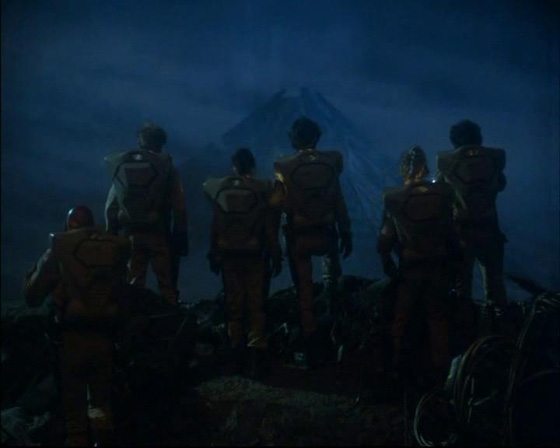 I was slightly reluctant to revisit the 1981 Roger Corman production Galaxy of Terror, but quickly realized, five or six minutes in, that the film I remembered disliking – that which I’d seen on cable a long time ago – was actually Forbidden World, the 1982 followup which reused the same sets. Luckily for me, Galaxy of Terror (recently made available on BluRay from Shout! Factory as part of the “Roger Corman Cult Classics” series) was not only something I had never seen before, but the superior product. Granted, you need to set your expectations accordingly. Famously known as an Alien rip-off (one of the many which emerged in the late 70’s and early 80’s), it’s a typical lowbrow Corman/New World production from this period, tasteless and exploitative in a manner which cult film buffs of a certain age tend to view with nostalgia. But to revisit Galaxy of Terror three decades later, one sees a film which, however daffy, exhibits more imagination and ambition than most films of its ilk, with special effects and set design that, for the most part, look much better than they cost.
I was slightly reluctant to revisit the 1981 Roger Corman production Galaxy of Terror, but quickly realized, five or six minutes in, that the film I remembered disliking – that which I’d seen on cable a long time ago – was actually Forbidden World, the 1982 followup which reused the same sets. Luckily for me, Galaxy of Terror (recently made available on BluRay from Shout! Factory as part of the “Roger Corman Cult Classics” series) was not only something I had never seen before, but the superior product. Granted, you need to set your expectations accordingly. Famously known as an Alien rip-off (one of the many which emerged in the late 70’s and early 80’s), it’s a typical lowbrow Corman/New World production from this period, tasteless and exploitative in a manner which cult film buffs of a certain age tend to view with nostalgia. But to revisit Galaxy of Terror three decades later, one sees a film which, however daffy, exhibits more imagination and ambition than most films of its ilk, with special effects and set design that, for the most part, look much better than they cost.
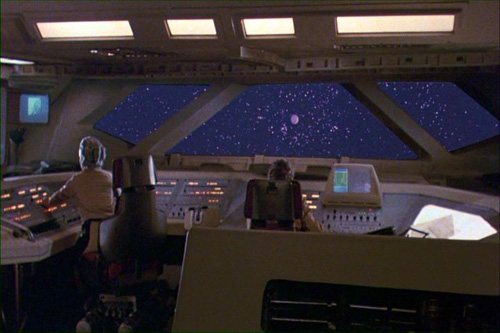 First, surely, one needs to approach Galaxy of Terror as an exploitation product, with equal emphasis on both of those words. The initial directive, issued from Corman, was to clone Alien, and hopefully duplicate some of its box office success. Science fiction horror was all the rage: we’d quickly get the likes of Saturn 3 (1980), Humanoids from the Deep (1980), Xtro (1983), Lifeforce (1985), Creature (1985), and even an Alien parody, Spaceship (1983), with Cindy Williams and Leslie Nielsen. Marc Siegler and Bruce Clark penned a screenplay which placed the Alien storyline into a purely Freudian context (as though the original film were short of Freudian overtones); rather than being stalked by a single deadly creature, the crew of the Quest faced a metaphysical conflict. Summoned to a towering pyramid on the desolate planet Morganthus, they are subsequently killed off, one-by-one, by their own worst fears. Corman approved the script, which Clark would direct, and only asked that they add a rape scene. Just a little one. For the foreign markets. At first horrified, Siegler and Clark ultimately elected to include a rape scene so absurd that it would sail past offensiveness and straight into another realm entirely – that of a bad acid trip.
First, surely, one needs to approach Galaxy of Terror as an exploitation product, with equal emphasis on both of those words. The initial directive, issued from Corman, was to clone Alien, and hopefully duplicate some of its box office success. Science fiction horror was all the rage: we’d quickly get the likes of Saturn 3 (1980), Humanoids from the Deep (1980), Xtro (1983), Lifeforce (1985), Creature (1985), and even an Alien parody, Spaceship (1983), with Cindy Williams and Leslie Nielsen. Marc Siegler and Bruce Clark penned a screenplay which placed the Alien storyline into a purely Freudian context (as though the original film were short of Freudian overtones); rather than being stalked by a single deadly creature, the crew of the Quest faced a metaphysical conflict. Summoned to a towering pyramid on the desolate planet Morganthus, they are subsequently killed off, one-by-one, by their own worst fears. Corman approved the script, which Clark would direct, and only asked that they add a rape scene. Just a little one. For the foreign markets. At first horrified, Siegler and Clark ultimately elected to include a rape scene so absurd that it would sail past offensiveness and straight into another realm entirely – that of a bad acid trip.
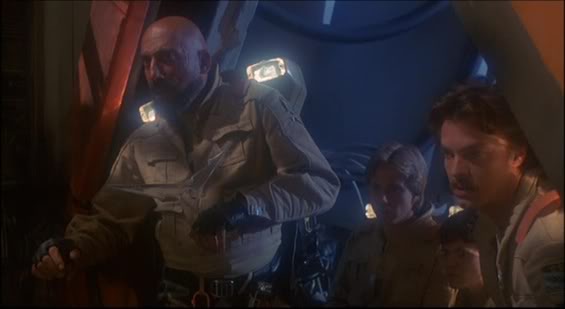 The secret weapon in Galaxy of Terror‘s arsenal was its effects unit, which featured a number of artists who would go on to bigger and better things. Chief among them was James Cameron, head of the special effects department for New World and quickly climbing the ranks; he oversaw all the effects work on this film and also served as assistant director. Roger Corman was famous for creating an environment that groomed talent: Jack Nicholson, Joe Dante, John Sayles, and Jonathan Demme all graduated from his B-movie schooling. Cameron also rocketed through Corman’s system, though his first stop as director was, unfortunately, Piranha Part Two: The Spawning (1981), before beginning his auteur career proper with The Terminator (1984). His design work in Galaxy of Terror is immediately identifiable. The blue-hued, misty, awe-inspiring sets and miniatures on display are mostly done in-camera, and strongly resemble the apocalyptic scenes in The Terminator and the fearsome planet “LV-426” in Aliens (1986). It might be irony that the director of an Alien cash-in would one day direct the official sequel, but Galaxy of Terror proved he could capture the required look and atmosphere.
The secret weapon in Galaxy of Terror‘s arsenal was its effects unit, which featured a number of artists who would go on to bigger and better things. Chief among them was James Cameron, head of the special effects department for New World and quickly climbing the ranks; he oversaw all the effects work on this film and also served as assistant director. Roger Corman was famous for creating an environment that groomed talent: Jack Nicholson, Joe Dante, John Sayles, and Jonathan Demme all graduated from his B-movie schooling. Cameron also rocketed through Corman’s system, though his first stop as director was, unfortunately, Piranha Part Two: The Spawning (1981), before beginning his auteur career proper with The Terminator (1984). His design work in Galaxy of Terror is immediately identifiable. The blue-hued, misty, awe-inspiring sets and miniatures on display are mostly done in-camera, and strongly resemble the apocalyptic scenes in The Terminator and the fearsome planet “LV-426” in Aliens (1986). It might be irony that the director of an Alien cash-in would one day direct the official sequel, but Galaxy of Terror proved he could capture the required look and atmosphere.
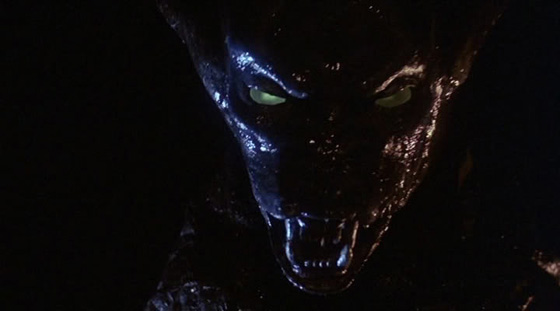 But this is, of course, a long way from Aliens, and Galaxy of Terror, for all its nifty effects, has a plot more suited for a bizarro 1970’s David Carradine vehicle. In fact, it’s a great shame that Carradine isn’t present, because he’s a perfect fit for “The Master,” the mysterious character with a brightly glowing head who summons the space explorers so they can play his deadly game. (Either Carradine or Alejandro Jodorowsky – but then it would be a very different film.) The crew is ostensibly following an S.O.S. call, a la Alien, but the spaceship which issued the call is filled with dead passengers, and as soon as they begin exploring the nearby pyramid, the body count immediately escalates.
But this is, of course, a long way from Aliens, and Galaxy of Terror, for all its nifty effects, has a plot more suited for a bizarro 1970’s David Carradine vehicle. In fact, it’s a great shame that Carradine isn’t present, because he’s a perfect fit for “The Master,” the mysterious character with a brightly glowing head who summons the space explorers so they can play his deadly game. (Either Carradine or Alejandro Jodorowsky – but then it would be a very different film.) The crew is ostensibly following an S.O.S. call, a la Alien, but the spaceship which issued the call is filled with dead passengers, and as soon as they begin exploring the nearby pyramid, the body count immediately escalates.
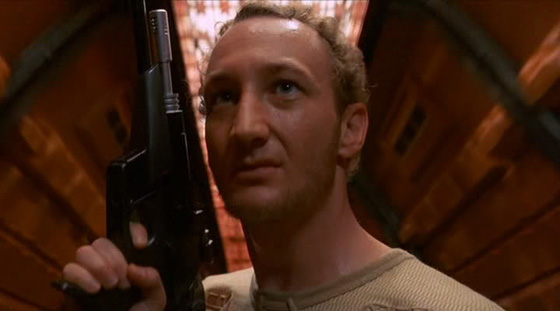 Along for this ride is a cult movie dream cast: Edward Albert (son of Green Acres star Eddie Albert) as the cool-headed hunk Cabren; Erin Moran (Happy Days and Joanie Loves Chachi) as the Deanna Troi-like empath Alluma; My Favorite Martian‘s Ray Walston as the cerebral Kore; a youthful Robert Englund (A Nightmare on Elm Street) playing Ranger; Zalman King (future director of erotic dramas like Wild Orchid) as Baelon; Grace Zabriskie (Twin Peaks) as the unhinged Captain Trantor; Bernard Behrens (The Changeling) as Commander Ilvar, and veteran character actor Sid Haig (The Devil’s Rejects) as a mercenary with giant ninja stars. Watching Joanie Cunningham, Freddy Krueger, and Captain Spaulding stalk dark alien corridors with laser rifles in their hands can send your junk-culture synapses crackling like pop rocks.
Along for this ride is a cult movie dream cast: Edward Albert (son of Green Acres star Eddie Albert) as the cool-headed hunk Cabren; Erin Moran (Happy Days and Joanie Loves Chachi) as the Deanna Troi-like empath Alluma; My Favorite Martian‘s Ray Walston as the cerebral Kore; a youthful Robert Englund (A Nightmare on Elm Street) playing Ranger; Zalman King (future director of erotic dramas like Wild Orchid) as Baelon; Grace Zabriskie (Twin Peaks) as the unhinged Captain Trantor; Bernard Behrens (The Changeling) as Commander Ilvar, and veteran character actor Sid Haig (The Devil’s Rejects) as a mercenary with giant ninja stars. Watching Joanie Cunningham, Freddy Krueger, and Captain Spaulding stalk dark alien corridors with laser rifles in their hands can send your junk-culture synapses crackling like pop rocks.
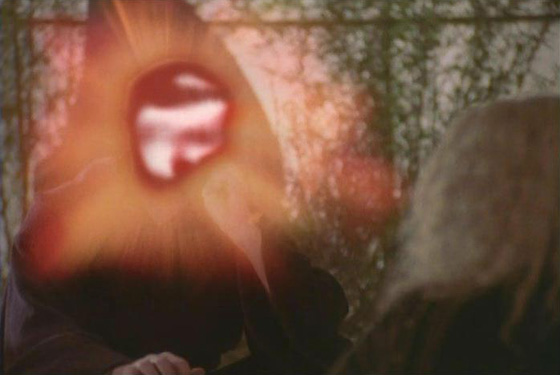 The dialogue they’re required to deliver is nonsensical at best, incoherent at worst. No wonder Sid Haig decided to throw out almost all of his lines (except for “I live and die by the crystals!”). Alluma gets to say, “Phaelon, I’m psi-sensitive. The subtle energies do exist. They even pay me to sense them, all right?” Ray Walston solemnly intones all sorts of mumbo-jumbo as his alter ego, Planet Master Xerxes. Unlike Ridley Scott’s film, which constantly hints at a larger science fiction universe, everything in Galaxy of Terror is skin-deep. The Quest corridors are impressive-looking at first, until you realize those are styrofoam hamburger containers pasted and spraypainted on the walls. In the first scene in the film, Xerxes orders Commander Ilvar to “put together a Class III ship, with normal exploratory and defense equipment.” A few scenes later, we’re treated to a close-up of a monitor displaying the Quest’s stats, and offering in bold letters: “Class III Mission Ship: Standard Compliment of Exploratory and Defense Equipment.” One doubts there was a Galaxy of Terror bible written for the crew to consult.
The dialogue they’re required to deliver is nonsensical at best, incoherent at worst. No wonder Sid Haig decided to throw out almost all of his lines (except for “I live and die by the crystals!”). Alluma gets to say, “Phaelon, I’m psi-sensitive. The subtle energies do exist. They even pay me to sense them, all right?” Ray Walston solemnly intones all sorts of mumbo-jumbo as his alter ego, Planet Master Xerxes. Unlike Ridley Scott’s film, which constantly hints at a larger science fiction universe, everything in Galaxy of Terror is skin-deep. The Quest corridors are impressive-looking at first, until you realize those are styrofoam hamburger containers pasted and spraypainted on the walls. In the first scene in the film, Xerxes orders Commander Ilvar to “put together a Class III ship, with normal exploratory and defense equipment.” A few scenes later, we’re treated to a close-up of a monitor displaying the Quest’s stats, and offering in bold letters: “Class III Mission Ship: Standard Compliment of Exploratory and Defense Equipment.” One doubts there was a Galaxy of Terror bible written for the crew to consult.
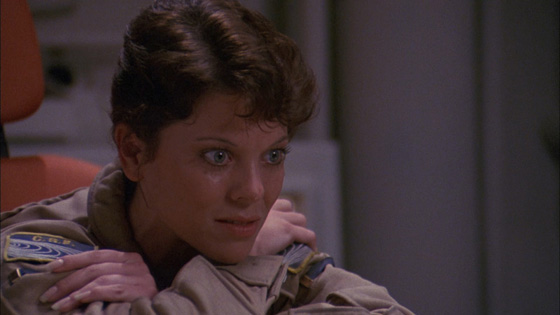 But for B-movie fans, many of the ridiculous touches are just lovely. When medical officer Dameia (Taaffe O’Connell) is conducting an autopsy with Robert Englund’s Ranger, she turns to the camera and wipes her sweaty brow with a blood-covered hand. Just before the scene cuts, the equally bloody Englund wipes his mouth (!). Earlier, we’re treated to Zabriskie’s Captain Trantor exhibiting borderline psychotic personality disorder as she speaks in a creepy, haunted voice about the earlier, disastrous mission for which she was in charge (“Hesperus!”) before she abruptly gives the crew thirty seconds to prepare for launch, and then no warning before she plummets the ship into a landing maneuver. (“I got you here,” she sneers at Commander Ilvar, “the rest is up to you!”) The ship’s coward is killed off immediately – by a Gigeresque xenomorph that scalps him – and, upon exploring the pyramid, Ilvar quickly follows. Taking the film at its word that these deaths represent the crew’s worst fears, one assumes Ilvar was really afraid of being punctured bodily by slimy tentacles.
But for B-movie fans, many of the ridiculous touches are just lovely. When medical officer Dameia (Taaffe O’Connell) is conducting an autopsy with Robert Englund’s Ranger, she turns to the camera and wipes her sweaty brow with a blood-covered hand. Just before the scene cuts, the equally bloody Englund wipes his mouth (!). Earlier, we’re treated to Zabriskie’s Captain Trantor exhibiting borderline psychotic personality disorder as she speaks in a creepy, haunted voice about the earlier, disastrous mission for which she was in charge (“Hesperus!”) before she abruptly gives the crew thirty seconds to prepare for launch, and then no warning before she plummets the ship into a landing maneuver. (“I got you here,” she sneers at Commander Ilvar, “the rest is up to you!”) The ship’s coward is killed off immediately – by a Gigeresque xenomorph that scalps him – and, upon exploring the pyramid, Ilvar quickly follows. Taking the film at its word that these deaths represent the crew’s worst fears, one assumes Ilvar was really afraid of being punctured bodily by slimy tentacles.
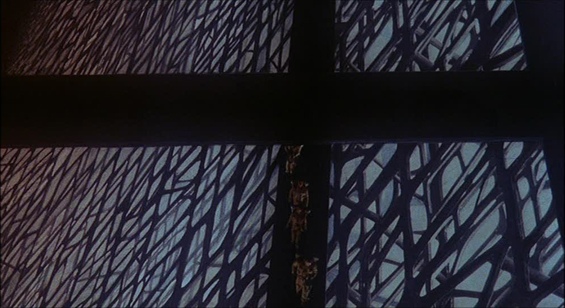 And Haig’s “Quuhod” – named, perhaps, when Marc Siegler passed out on his keyboard – must have been deathly afraid of his own throwing stars, which you need to reconcile with the fact that he’s been brandishing them with pride throughout the film. His ninja-star death scene is elaborate, to say the least. One of the blades launches into his arm and begins working its way upward, crawling beneath his flesh. Without a moment’s hesitation, Quuhod lops off his own appendage…at which point the severed arm throws the star back at him, killing him instantly. Dameia later discovers the limb, now crawling with maggots. One of the maggots, via stop-motion, grows to giant-size, and lumbers on top of her. Pressed beneath its slime, her clothes promptly vanish, and the maggot has its way with her squirming body. Corman reportedly directed this scene himself, because you don’t want to mishandle slimy maggot rape.
And Haig’s “Quuhod” – named, perhaps, when Marc Siegler passed out on his keyboard – must have been deathly afraid of his own throwing stars, which you need to reconcile with the fact that he’s been brandishing them with pride throughout the film. His ninja-star death scene is elaborate, to say the least. One of the blades launches into his arm and begins working its way upward, crawling beneath his flesh. Without a moment’s hesitation, Quuhod lops off his own appendage…at which point the severed arm throws the star back at him, killing him instantly. Dameia later discovers the limb, now crawling with maggots. One of the maggots, via stop-motion, grows to giant-size, and lumbers on top of her. Pressed beneath its slime, her clothes promptly vanish, and the maggot has its way with her squirming body. Corman reportedly directed this scene himself, because you don’t want to mishandle slimy maggot rape.
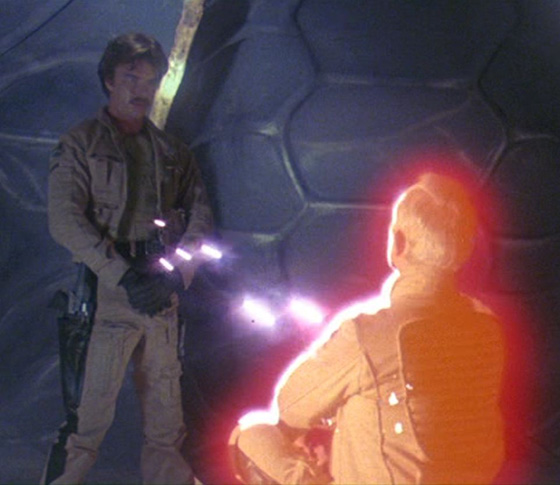 Of the remaining crew, only Erin Moran’s Alluma and Edward Albert’s Tom Skerritt-like Cabren seem to stand a chance at conquering the pyramid’s horrors, but when Alluma finds herself squeezing through a claustrophobic tunnel, tentacles erupt from all sides and squeeze her to death. If you want to see Joanie Cunningham’s head explode, Scanners-style, this is the movie for you. Cabren confronts the Master, now revealed to be Ray Walston, and learns that the pyramid is a “child’s toy” (apparently with the warning label removed) built by an ancient race to allow them to conquer their fears. Cabren, after facing off against the living corpses of his crew, manages to destroy the Master by firing lasers from the center of his body. (See, how can David Carradine not be in this?) He now becomes the Master himself, for a sequel that never arrived, unless you count the generally unrelated Forbidden World.
Of the remaining crew, only Erin Moran’s Alluma and Edward Albert’s Tom Skerritt-like Cabren seem to stand a chance at conquering the pyramid’s horrors, but when Alluma finds herself squeezing through a claustrophobic tunnel, tentacles erupt from all sides and squeeze her to death. If you want to see Joanie Cunningham’s head explode, Scanners-style, this is the movie for you. Cabren confronts the Master, now revealed to be Ray Walston, and learns that the pyramid is a “child’s toy” (apparently with the warning label removed) built by an ancient race to allow them to conquer their fears. Cabren, after facing off against the living corpses of his crew, manages to destroy the Master by firing lasers from the center of his body. (See, how can David Carradine not be in this?) He now becomes the Master himself, for a sequel that never arrived, unless you count the generally unrelated Forbidden World.
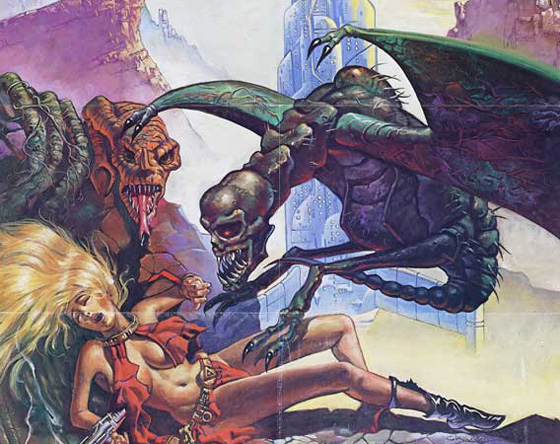 The shooting title was Quest, with the intention of changing it once they’d tricked some respectable actors into signing on. Galaxy of Terror was the most common title upon release, though it went out in some areas as Mindwarp: An Infinity of Terror. The Shout! Factory release includes a reversible sleeve, so you choose which title and poster you like. It’s hard to beat Galaxy of Terror‘s iconic, pulpy art, featuring a large-breasted blonde ravished by a phallic winged demon, though Mindwarp does offer its own addled take on Alien‘s famous tagline…”It’s always midnight in space!”
The shooting title was Quest, with the intention of changing it once they’d tricked some respectable actors into signing on. Galaxy of Terror was the most common title upon release, though it went out in some areas as Mindwarp: An Infinity of Terror. The Shout! Factory release includes a reversible sleeve, so you choose which title and poster you like. It’s hard to beat Galaxy of Terror‘s iconic, pulpy art, featuring a large-breasted blonde ravished by a phallic winged demon, though Mindwarp does offer its own addled take on Alien‘s famous tagline…”It’s always midnight in space!”









